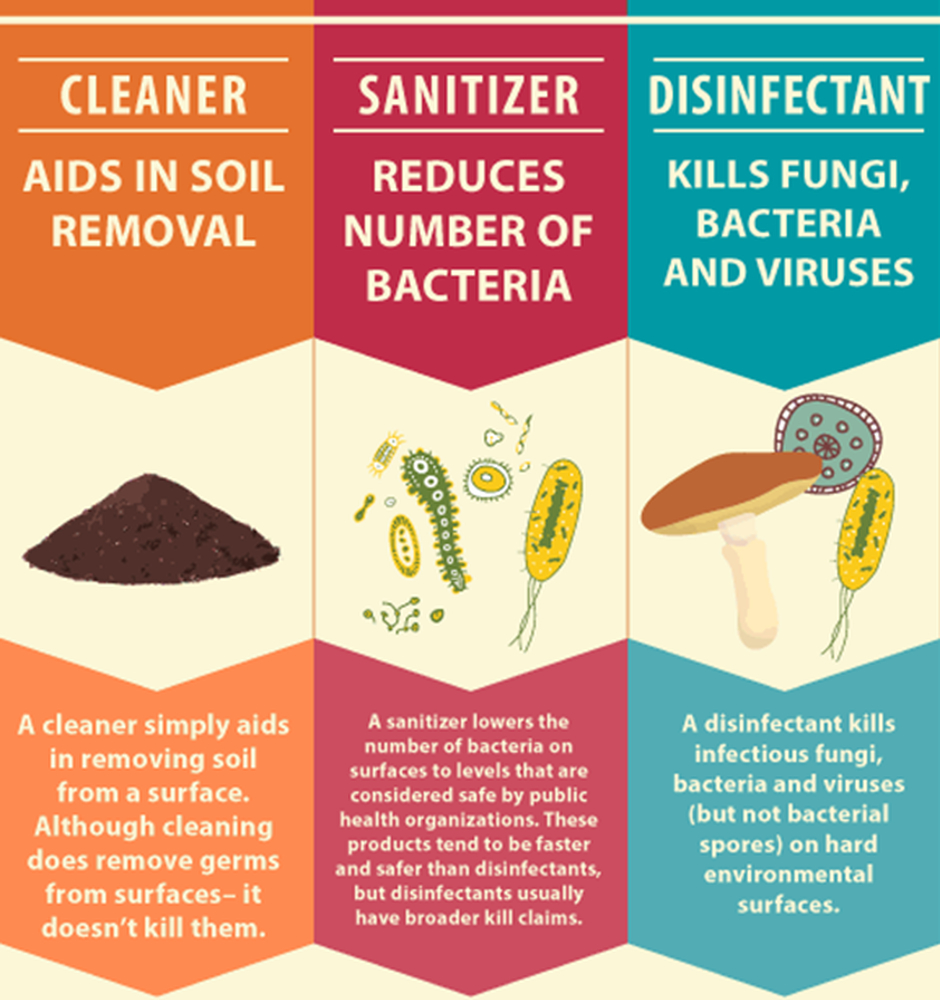Cleaning And Disinfecting Your Fixed Seating Products
By Anne Chapman
April 5, 2021
CDC And EPA Guidelines

The cleaning guidelines for all Irwin products align with the guidance from the U.S. Centers for Disease Control and Prevention (CDC).
- Work with your Facilities and Environmental Health and Safety staff to determine how frequently your products should be cleaned.
- CDC has advised that the most effective methods for preventing the spread of viruses and germs are wearing masks, washing hands frequently and adhering to social distancing guidelines.
- On April 5, 2021, the CDC updated its guidance for cleaning and disinfecting facilities to prevent the spread of COVID-19. This update places emphasis on hand hygiene for substantially reducing the risk of SARS-CoV-2 transmission from contaminated surfaces, while surface disinfection once- or twice-per-day had little impact on reducing estimated risks.
- For the latest information on potential exposure pathways for COVID-19 infection, including contact with surfaces, please see the CDC website.
If you are searching for a disinfecting product to use in your venue, the U.S. Environmental Protection Agency (EPA) provides a comprehensive list of all cleaners approved to prevent the spread of COVID-19, along with the surfaces they are intended for. If you have a cleaning or disinfecting product but can't find it on the EPA's list, look at a your product's label to confirm it has an EPA registration number and that human coronavirus is listed as a target pathogen.
Technically, a soft surface, such as upholstered furniture, cannot be 100% disinfected. While "disinfect" is the common buzzword during these challenging times, it's important to understand that hard surfaces, such as chair arms, backs and standards can be disinfected, but soft surfaces, with their contours and seams, can be sanitized. Applying disinfectant to soft surfaces does not mean that they are 100% disinfected. Given the airborne transmission of the COVID-19 virus, your venue's social distancing measures, HVAC upkeep, masking policies and hand washing or hand sanitizing stations are most important in keeping your guests safe.

We do understand that disinfectants are being applied to seating, as venues take extra measures to contain the spread of COVID-19. Often, an entire facility is treated with the same disinfectant. Facilities are challenged with meeting public expectations for cleanliness, while facing the time and cost considerations from extra cleaning and decreased programming. With this in mind, we encourage the use of equipment such as electrostatic sprayers or atomizers to apply disinfecting products within your building.
Applying disinfectants to contract fabrics presents its own challenges. Aggressive or over-applied disinfectants and cleaning products may cause discoloration other changes to the fabric. Best practices are important when using these products, to ensure the longevity of your fabric and seating.
Please see our library of all Irwin Seating fabrics and finishes. If you have questions regarding the fabrics and finishes on your seating, please contact us.
Cleaning And Disinfecting Chairs With Coated Fabric Surfaces: Vinyl & Polyurethane
Vinyl and polyurethane have always been easy to clean, making them popular in high-use areas. From the largest stadiums to the newest luxury cinemas, this fabric choice is found where people gather. Easily cleanable, vinyl and polyurethane fabric can make it through COVID-19 and be there for your guests in brighter times, providing best practices are used. As with any upholstery, it's important to first know which coated fabric is on your chairs. Your seating provider will have this information.
Our partners at Culp Contract recommend this process to sanitize their polyurethane: apply a water to bleach solution of 10:1, then rinse the cleaned area with water and dry with a clean cloth. CMI Enterprises recommends the same process for their vinyl products; a 10:1 water to bleach dilution for with a clean water rinse following the application, then towel dry.
Rinsing and wiping down the seats after you disinfect your venue is important to protect your fabric from damage. Gradual build-up of cleaning products can saturate polyurethane and lead to de-lamination, and it can dry out vinyl and lead to cracking.
Before you disinfect your building, it's recommended you clean your polyurethane or vinyl upholstery with a detergent or general purpose cleaner. Cleaning is a great place to begin, because it physically removes soil, organic matter, and many germs from the surface. It is also recommended as ongoing maintenance for your seating. Wipe the seats with a clean, damp cloth after you've cleaned.
Disinfecting should always take place last, to ensure that any germs leftover after cleaning are destroyed. Disinfectants are not as effective when applied directly to dirty surfaces, because germs and viruses can hide under soils.
Use disinfectants in the proper concentration, following the manufacturer's recommendations on the label. Do not over-saturate the fabric. When possible, apply the disinfectant with an electrostatic sprayer or atomizer, which produce a fine mist that is more forgiving to upholstery.
- Always test the disinfectant first on an inconspicuous area of the surface.
- We encourage wiping the seats with a clean damp cloth after you disinfect your venue, to remove excess residue. Excess residue can build up over time and potentially degrade the upholstery. The residue can also create a less-than-desirable experience for your returning guests.
Here are a few disinfectants that can be used to help combat lingering bacteria and virus pathogens. Irwin has conducted informal resistance testing for these products against a variety of fabric types.
- 409 Multi Surface: A registered disinfectant that kills 99.9% of bacteria
- Virex II 256: Used in health care - highly concentrated quaternary formula provides one-step cleaning and disinfection
- Other commercial disinfectants with anactive ingredient of hydrogen peroxide or quaternary ammonium, diluted to label instructions and applied with an electrostatic sprayer or atomizer, seem to provide a cost-effective option.
Cleaning And Disinfecting Woven Fabric Surfaces
Woven fabric was not developed to be disinfected, and there was no precedent for how, or even if disinfectants should be applied. What is clear is that it's important to know which fabric is on your chairs. Your seating provider will be able to help you identify the fabric on your chairs. Understanding the requirements of your fabric will help you select the best product for disinfecting your facility.
Like with coated fabric, it's best to take advantage of the current limited crowds and programming and give those chairs and woven fabric a good cleaning before you disinfect. This regular maintenance is recommended for both the upholstery and the chair itself.
To clean woven fabric, please follow the Association for Contract Textiles (ACT) cleaning resources and considerations. Again, knowing which specific fabric is on your chairs is key. Cleaning symbols or letters are used to identify the cleaning guidelines. These can be found on the fabric company’s website. (Note - these guidelines are specific to cleaning, not disinfecting your fabric).
- Wet (W) cleaning means the use of steam cleaning or hot water extraction are acceptable means of cleaning. You can also use water-based cleaning agents and a clean towel to dab out some spots. It is best to use plain white towels when cleaning, so you do not transfer any color die onto the fabric.
- Solvent (S) cleaning means that the fabric is sensitive to water and wetting it may leave permanent water rings or cause the material to shrink. In order to prevent these damages to the item, use solvent based cleaners. Solvents are used to break down soiled oily spots and leave the area dry. It is best to vacuum after these types of applications to remove the soil which has been separated from the fabric.
- Wet cleaning and solvent cleaning (WS) fabrics use both types of cleaning methods on different spots. It is recommended that for oily areas, solvents are to be used, and for water-based spots, water-based cleaners are to be used. The best procedure for these types of fabrics is to first use wet cleaning methods. If that fails, try solvents.
- No cleaning (X) is found when you furniture is not meant to be cleaned. This type of material is only meant to be vacuumed and brushed to remove dry soils. The reason is because shrinking, staining, or distortion of the surface pile may occur.
If you will be applying disinfectant to you woven fabric, plan to apply in a fine mist, such as with an electrostatic sprayer or an atomizer. It's important not to saturate the fabric. Our observations have been that disinfectants with an active ingredient of quaternary ammonium or hydrogen peroxide seem to be a cost effective approach. The fine-misting application methods reduce the risk of over saturation, speed drying times and provide venues a cost-effective option.
Worth noting as well are fabrics which have been treated with an antimicrobial finish. Antimicrobial treatments protect the product from degradation by microbes and bacteria, but are not intended to limit infection among humans, and do not work against viruses, such as COVID-19.
These links to Irwin Seating standard woven fabric vendors may also provide helpful tips for both cleaning and disinfecting:
• Absecon Mills
• Designtex
• Gilford of Maine
• KM Fabrics
• Maharam
• Mayer Fabrics
• Momentum Textiles
• CF Stinson
Disinfecting Hard Chair Surfaces Laminate, Painted Metal & Plastic
Consider one of the following commercial cleaning products. Always use in accordance with the manufacturer instructions.
- Clorox Healthcare Bleach Germicidal Cleaner – EPA registration number 67619-12
- Professional Lysol® Disinfectant Spray – EPA registration number 777-99
- OXIVIR® TB – EPA registration number 70627-56
- Virex II 256 – EPA registration number 70627-24
- All-purpose hard-surface cleaner (examples include Formula 409, Fantastik or Mr. Clean)
Metal
Clean with a non-abrasive cleaner.
Wood
Use a cleaner or flax soap formulated especially for use on wood surfaces.
Inform Your Customers & Understand Their Concerns
Communicating your cleaning and disinfecting protocol with customers will be key to making your guests feel safe again, and now is a great time to begin that dialog. Customers want to understand the extra steps taken to sanitize all areas of your facility, and additional measures that will become the new normal. Consider posting your COVID-19 cleaning and disinfecting procedures to your website, social media pages, blogs, newsletters, and other methods used to communicate with patrons.